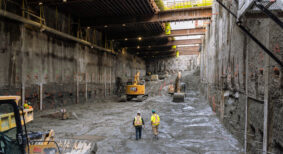When the B.C. government introduced the Community Benefits Agreement (CBA) in July 2018 for key public-sector infrastructure projects, it set off a heated and polarizing debate within the construction industry.
The CBA, according to the government, is intended to deliver good-paying jobs, better training and apprenticeships and more trades opportunities for Indigenous peoples, women and youth around the province. A newly created Crown corporation, BC Infrastructure Benefits Inc. (BCIB) will hire the project’s construction workers, and will work with unions and contractors to dispatch labour, as well as manage payroll and benefits.
But at issue for many opponents is the requirement that any non-union worker or a worker from another affiliation must join the building trades union for work specific to the project. Companies will also not be able to do the work with their own employees, raising serious questions about safety, risk and productivity.
Debate over the merits of the CBA was the focus of the construction keynote panel at Buildex Vancouver 2019. The overall session raised more questions than answers with moderator Chris Atchison, president of the B.C. Construction Association, keeping the “passion” around the policy in check.
The five speakers discussed key points of the CBA, apprenticeship numbers, what is good public policy, and dispelled some myths.
All the panelists agree that a severe skills shortage is a significant challenge for the industry and providing apprenticeship and skills training opportunities is critical to ensuring a future workforce. But the use of a project labour agreement model in the CBA to achieve this is sparking diverse opinions.
“We need political leadership to bring people together, not divide people,” stated Chris Gardner, president of the Independent Contractors and Businesses Association (ICBA). “Unfortunately this policy initiative is dividing the construction workforce.”
The session started with BCIB board chair Allan Bruce providing background on the board and its mandate to implement the CBA. He highlighted the benefits of the agreement which includes a project labour agreement and increased opportunities for apprentices.
The project labour agreement will “maintain stability, no lock outs, define wages and provide transparency on wages,” he said. “The CBA will help develop the next generation of workers and create a pipeline for those apprentices to gain skills they need to move to journeyperson status.”
He noted Indigenous people are the fastest growing segment of the population and women are vastly underrepresented in the trades. The CBA prioritizes the hiring of apprentices, Indigenous workers, local residents and women in trades.
“If B.C. is going to meet the skills shortage challenge, it’s going to need to develop new workers from those pools. The CBA provides the action plan and tools needed to make real meaningful change,” he said.
Bruce also addressed what he called “falsehoods that are being perpetuated” about the CBA. He asserted that no workers in B.C. will be denied the opportunity to be considered for work if they are qualified, and that no contractors will be denied opportunities to bid work on projects.
Gardner responded by pointing out: “Yes, any company can bid the work. What he left out is the companies can’t take their employees with them if they win a contract. They will bid the work but the union halls will dispatch the workers. It’s bureaucracy, it’s red tape, it’s not fair and it’s discriminatory.”
Paul DeJong, president of the Progressive Contractors Association of Canada, voiced similar concerns: “Contractors can bid but under a drastically different and compressed business model. Transfer of risk is a big concern. Employers who have taken a great amount of time to train their own workers are unable to deploy their own workforce. Contractors are going to price that risk into the model.”
DeJong focused his presentation on what is good public policy and why the CBA fails miserably. His main criticism centred around the lack of consultation or the “limited and exclusive consultation” on the CBA.
“Organizations like my own were not included and like ICBA, we represent the majority of the industry beyond the building trades,” he said. “Good public policy hinges on a democratic process…. has to be fair and open for all.”
Another concern for DeJong was that without clear targets for hiring women or Indigenous people, there are no metrics for measuring success or making improvements.
Tom Sigurdson, executive director of the BC Building Trades, shared his perspective by stating, “We have a policy now that respects apprentices. Every contractor – non union or union – will be involved.”
He noted the CBA framework is not new and project labour agreements were used under previous B.C. Liberal governments and dates back more than 50 years. Projects under PLAs saw much higher percentage of local hires.
He cited Site C as an example of a large public project that has a disappointing low number of apprentices and local B.C. workers. The open managed site “has resulted in 22 per cent of the labour force on that project or 690 workers coming from outside B.C. while our qualified workers are sitting at home.”
Sigurdson stressed the benefits of a CBA to address the skills shortage, how his organization supplies qualified labour to signatory contractors and criticized ICBA’s embarrassing ratio of apprentices to members. He disagreed that the agreement is restrictive or exclusive, challenging Gardner (with a payment of $1,000) to show him where in the new CBA it excludes any contractors.
He also wanted to dispel the myth about his membership, saying the building trades focus primarily on ICI construction and constitute about 55 per cent of the workforce.
Meanwhile, ICBA and other organizations have consistently stated the building trades comprise only 15 per cent of the workforce which is another reason why they object to the CBA.
“The challenge with the CBA is very simple,” said Gardner. “There was absolutely no consultation. The government didn’t form a panel or a committee to travel around the province and ask British Columbians how do we deliver construction projects better. What they did was they cut a deal in a backroom with the building trades.”
Gardner called forcing workers to leave their existing companies and employment benefits to join a building trade “ridiculous.”
“We have significant challenges in the workforce. But the answer to those challenges is not: you can bid the work but you are not guaranteed a workforce that is yours. Workers deserve choice and flexibility,” he said.
To defend workers’ choice, ICBA along with other construction associations, unions, businesses and individuals have filed a petition to the B.C. Supreme Court to strike down the hiring model.
“On February 27th, we are going to be in B.C. Supreme Court saying this doesn’t make sense. We’re going to be joined by effectively the entire construction industry except the building trades. All those people aren’t wrong. This is a flawed policy – flawed from the get-go and should not stand.”
Cheryl Mah is managing editor of Construction Business.









